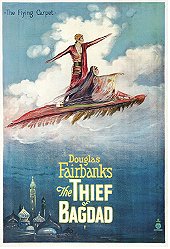Douglas Fairbanks, one of the great founding fathers of cinema, introduced numerous characters to the silver screen – Robin Hood, Zorro, the Three Musketeers, and in this film, he brought the flavor and images of the Arabian Nights to vivid life. The Thief of Bagdad is pure spectacle and lavish production design, held together by Fairbanks’ live-wire and stunt-heavy central performance.
Despite not being the director of this material, Fairbanks feels like the main guiding hand of this production. Great movie stars had a talent for doing this, warping directors and material into their great personas. The outcomes varied, but Fairbanks and director Raoul Walsh crafted something truly magical with The Thief of Bagdad.
Narrative coherence and deep substance is not its main concern, and occasionally the bloated running time does make some of it a little heavy to work through, but the journey is beyond worth it. Fairbanks plays Ahmed, a thief who lives by his wits, who uses a magic rope to steal from the caliph. While pilfering the palace, he spots the caliph’s beautiful daughter, and falls in love. Wanting to see her again, he steals various items to make him appear to be a wealthy suitor. And the plot keeps swirling on, throwing in a Mongol prince plotting to conquer the city, a traitorous slave girl, a flying carpet, a horse with wings, and numerous other set pieces that linger in the imagination.
While the 1940 remake may have streamlined the film’s various plot strands and cohered into a more manageable plot line, that doesn’t mean the original doesn’t hold its own against that highly revered classic. William Cameron Menzies production design is a thing of grandiosity and opulence, creating a magical kingdom which could only exist in the movies. This is probably the strongest selling point of the movie, along with the special effects work that, for the time, were as forward-thinking and seamless as the work in modern films like Gravity.
The greatest of all special effects may be Fairbanks’ physicality, as he does daring stunts and feats that often feel like he’s thumbing his nose at gravity and the laws of physics. These things never seem to apply to him, he exists as lightning in human form. He moves with a feline grace in some moments, but in others he bounces around like he’s what would happen if a rubber ball gained sentience and mobility.
Most of the supporting players recede into the background, mainly Fairbanks’ romantic interest, Julanne Johnston. Johnston looks stunning in her various costumes, but she’s given little to do aside from this. The lone supporting player who makes a lasting impression is Anna May Wong as the duplicitous slave girl. Beautiful and deadly, she’s a toxic snake hidden in a tranquil and lovely garden. She makes the most of her screen time and leaves you wanting more from her. She does a similar thing in Shanghai Express, and gets to generate intense sexual chemistry with Marlene Dietrich in that film as well.
A lot of time, effort, love, and care went into the production of this film. In 1924, it flopped, but time has only been kind and loving to it. It now stands as possibly the greatest film that Fairbanks made. A masterpiece of spectacle and pure entertainment. Here is a fairy tale land that never existed outside of the movies, an enchantment which demonstrates the transported and transformative powers of the cinema.
 Login
Login